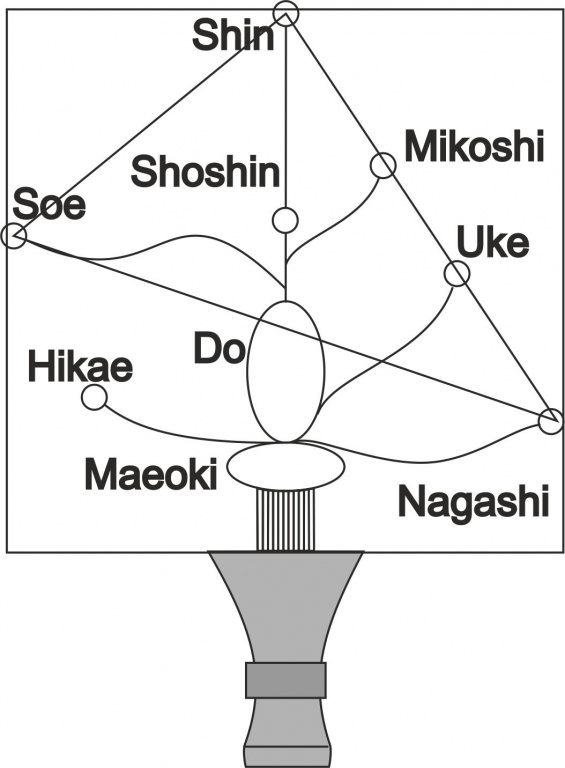Rikka
Rikka is a form of Japanese floral art that emphasizes the simplicity, naturalness, and beauty of nature. Rikka differs from other forms of arrangement in its strictness and symbolism. It incorporates specific rules for flower arrangement using association with elements of nature such as trees, hills, rivers and waterfalls. This art developed during the Middle Ages in Japan and has its roots in Zen Buddhist philosophy, which proclaimed an understanding of the world through meditation.
The main aim of Rikka ideology is to convey emotions and thoughts through the arrangement of natural elements. It is not just a decoration, but rather a way to convey certain concepts of landscape and create harmony between man and nature.
Ricca has reached the highest degree of development of this art, whose object is the beauty of the plant world, perceived as something sublime and mysterious. The arrangement, for all its complexity, demonstrates the adoration of nature through the numerous elements that allow to show this wonder.

Rikka is composed of seven to nine branches:
- Shin is the heart of the composition, pointing upwards and is the most powerful and tallest central branch.
- Shoshin (Shoshin) - the top center, stabilizing the composition. This element has no curves and does not project in space, creating a focus in one point. From a spiritual point of view, contemplation of Shoshin brings peace of mind. The material is chosen depending on the season: flowers in spring and summer, tree branches in fall and winter - plum, peach, pine and juniper. The flowers are placed in front of the Shoshin, the woody materials behind. The height of the Shoshin is 0.5-0.7 of the height of the Shin.
- Soe (an added branch), which is a support. It is also oriented upward but is smaller in size. It is placed at a 45 degree angle to the left and back. Soe along with Nagashi give width to the composition. The material is a different material from Shin, to create contrast.
- Mikoshi is placed below Shoshin and angled backwards to create depth.
Light and flexible branches of pine, plum or weeping willow are suitable as material.
- Uke has the role of extending the back part of the composition, while creating depth. It is customary to use the same material as Shin.
For balance, Uke should be the same length as Hikae.
- Hikae creates spatial breadth and depth in the foreground of the composition. It is placed opposite Uke and is the same length. Materials: chrysanthemums, pine, juniper, dogwood or willow. To avoid monotony, the material should be different from that used for Nagashi.
- Nagashi expresses the smooth movement of water in a stream or river at the lower level of the composition. To make Nagashi as effective as possible, the following rules should be followed:
- make the exit point of the arrangement inconspicuous;
- to give volume or lushness to the tip of the Nagashi;
- to express strength, the tip of the branch should not hang down.
- Do camouflages the connections of the main branches and provides stability to the lower center section. It is usually a dense and sturdy structure made of thick material, with lush and rich foliage. Materials include juniper, cypress, pine, boxwood, plum, peach, willow, peony. Despite the fact that the space for Do is limited, he has the role of creating a sense of spaciousness in the composition.
- Maeoki is a forward-protruding branch that stabilizes the lower part, and also marks the imaginary line of water. Dense and small-leaved plants such as boxwood or pine are used as material.
Shin, shoshin and mayoki form the core of the composition, and the other branches help to create the overall harmony.
The traditional Rikka style has undergone great changes in its history. Originally, Rikka was intended for large spaces: castles, palaces, temples, spacious homes of nobles, samurai and merchants. It was considered a symbol of prosperity and glory. Creating Rikka required a lot of knowledge and secrets that were passed down through inheritance. The spectacular nature of this style served to utilize it at festivals, celebrations, meetings of important persons and as expensive gifts. This has served to develop and change the style - there are now more than 30 known Rikka styles. The style now has modern forms for its expression and allows for the use of a variety of flowers, leaves and grasses. The size and shape of the composition, as well as the number of elements can vary depending on the author's wishes. The monumental tradition of Rikka art is always guessed in the contemporary compositions.
